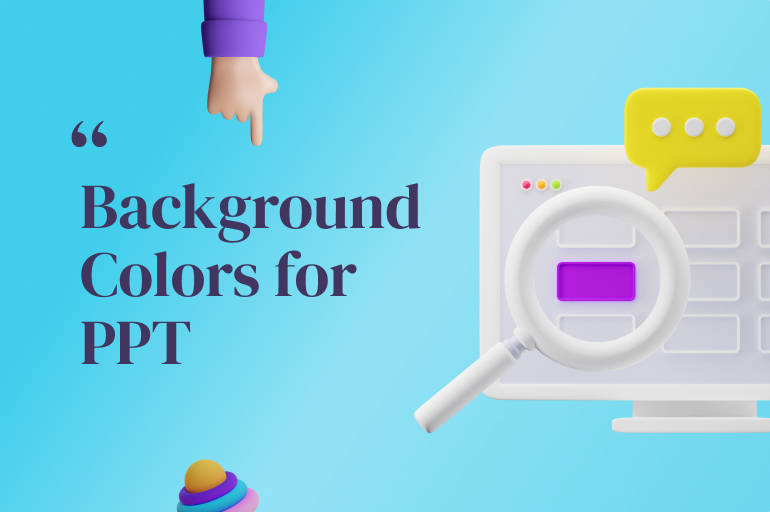Even if you’re relatively new to the digital world and creating presentations, mastering the use of background templates isn’t rocket science. A template is an outline or pattern that is used to reproduce a variety of things. In this case, a framework that serves as a background for slides in presentations.
A PowerPoint template, for example, provides a foundation for each slide by standardizing elements such as background patterns, colors, and format. Using this kind of template allows you to work more freely with your content. With a well-designed template in place, you’ll know that you need to present your final product attractively and effectively.
Importance of backgrounds in design and presentations
Whether you’re a student presenting a project or a professional pitching a product to a company, putting together a cohesive display that stands out is a must to impress the audience. Engagingly conveying a point relies on the quality of your graphics, content, and confident performance. A great background can distinguish between a forgettable lecture and a meaningful interaction that furthers a professional relationship.
When choosing the best background colors for presentations, there are several elements to consider:
- The color or colors of the background
- Background style, design, and pattern
- Visual “interaction” between the content and background
- Choosing a suitable font—appropriate for content and background style
- Format—working with the content and background to create a cohesive slide
These are not the only points to keep in mind. But by giving them some thought, you’ll be halfway to deciding on the best background template for your work.
Background colors
We all know that color is powerful—”feeling blue,” “in the red,” or “going green” are three phrases that we find easy to understand. Different colors evoke different emotions in people. Colors can have a profound effect on their “relationship” with the content that is being presented.
A basic understanding of color theory can be helpful when choosing your best background colors for presentations.
Deciding which colors to use in your slide backgrounds is easier if you consult the color wheel. In doing so, you can choose combinations that are appropriate and effective. The color wheel can provide a visual framework that supports your message by showing how different colors work together to create balance. The goal is to elicit your audience’s desired reactions (emotionally, for example) and actions.
Complementary colors are opposite one another on the color wheel—such as purple and green. On the other hand, analogous colors are three hues next to one another on the wheel. You can adjust these colors by altering their saturation, tone, or shade. Increasing saturation can make colors more vibrant, which suits more upbeat content.
Some colors and color combinations used in background templates lend themselves to more formal and professional content. Someone presenting at a conference would lean towards more muted colors such as blue, gray, brown, black, or white. These colors are unobtrusive and effective when communicating more severe content.
Looking at the interaction between the background and font, it is clear that the color of the typography must work well with that of the slide. Consider this example: If you’re working with analogous colors for your background, keeping the color of your font in that general framework makes your slides look more professional.
See also: Add Background Graphics in PowerPoint (Step by Step)
PowerPoint background templates
PowerPoint presentations can be hard to execute effectively. One of the key elements is to use the most appropriate background template. As we have mentioned, color is a huge part of designing engaging graphics and supporting content. Each slide in a presentation should use precisely the same template about colors. But the layout can get adjusted depending on the information you’re communicating.
For example, in a business setting, with important clients, the last thing you want to do is use inappropriate colors in a presentation about data security and privileged access management. Not only would this look unprofessional, but it would also distract from the seriousness of the information you are trying to get across.
Microsoft Word background templates require the same approach as Powerpoint background templates, as do background templates for Google Slides. When you communicate content to an audience, visuals play a part no matter what software you’re using.
There are many options to choose from when looking at Powerpoint background templates. Designs that are formal, upbeat, or emotive make different impressions on an audience.
See also: Best Background for PowerPoint Presentation Design Ideas
Some typical background designs
There are many different styles of background colors for presentations that work well for various types of content. Finding a suitable template requires a little research and experimentation.
A shortlist of some template styles includes solid color backgrounds, gradient backgrounds, images as backgrounds, and pattern backgrounds. Each of these slide backgrounds is easy to customize to suit your needs.
Simplicity – solid color backgrounds
Regardless of what type of template you’re creating, choosing a plain and understated background can make your content stand out. This style of slide background allows the content to be the center of attention. The solid color background is very effective when you want your audience to feel calm and relaxed.
Using two complementary colors also works in this way. Adjusting the hue or saturation of your first color can give you a lovely, subtle contrasting pigment that highlights the font on the slide without being distracting.
Sophistication – gradients
Gradient backgrounds can work in a similar way to solid-colored backgrounds. But they have more range in terms of which colors you select. The transition from one color to another lends a smooth, digital appearance to a slide background.
See also: Add Background Graphics in PowerPoint (Step by Step)
Context and engagement – images as backgrounds
Choosing the best background colors for presentations using an image can help convey a message and tell the audience more about your content without getting too wordy. Pictures evoke emotions more easily than abstract designs and can appeal to people’s imaginations.
Boldness – patterned backgrounds
Using patterns effectively directs the audience’s eyes to the essential bits of information on a slide. However, patterns need careful selection as they cannot overpower the content.
See also: Change PowerPoint Graphic Background You Cannot Edit
Make your slide background colors for presentations stand out
These are not the only styles of slide background templates. However, they should give you some ideas to ponder when you start planning your next presentation. Apply what works for you, and your presentation is sure to stand out.
Let’s visit RRSlide to download free PowerPoint templates. But wait, don’t go anywhere and stay here with our RRGraph Design Blog to keep up-to-date on the best pitch deck template collections and design advice from our PowerPoint experts.

As an editor, Lois covers topics around web design, marketing, and cybersecurity. To recharge in between writing projects, she goes surfing or skating. And, at the end of the day, a good book is always her favorite companion. She is currently working on Framer.





